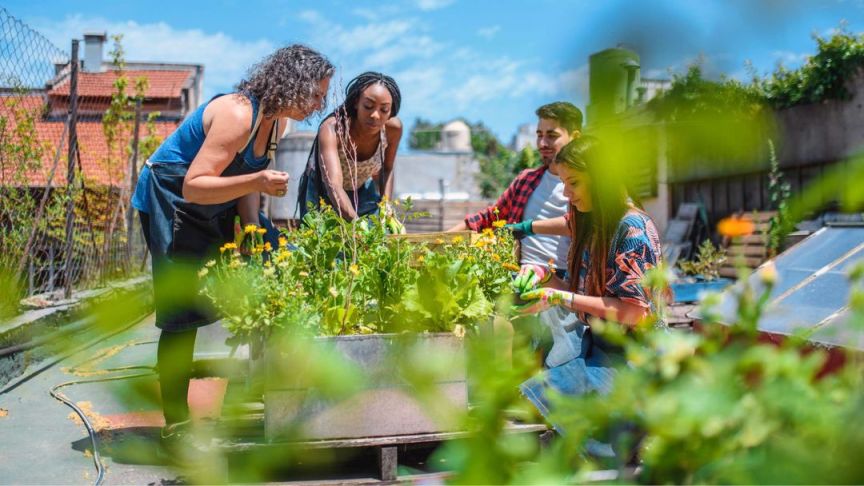In today’s fast-paced world, where urbanization and concrete jungles seem to be the norm, the idea of a community garden might seem like a breath of fresh air. A community garden is a shared space where people come together to grow fruits, vegetables, herbs, and even flowers, fostering a sense of community, sustainability, and environmental stewardship. If you’re someone who values the importance of fresh produce, local food sources, and the therapeutic benefits of gardening, starting a community garden might be the perfect project for you. Check out these awesome related posts on composting food scraps unleashing nature’s magic: the incredible benefits of composting food scraps and reducing waste and upcycled crafts the ultimate guide to upcycled crafts for adults: unleash your creativity and sustainability for more eco-friendly tips.
Why Start a Community Garden?
Starting a community garden offers numerous benefits, both for the individuals involved and for the community as a whole. Here are some compelling reasons to consider this endeavor:
-
Access to Fresh, Locally-Grown Produce: By growing your own fruits and vegetables, you’ll have access to nutritious, locally-sourced produce that’s free from harmful pesticides and synthetic fertilizers.
-
Promoting Environmental Sustainability: Community gardens are a prime example of sustainable living. They reduce the carbon footprint associated with transporting produce over long distances, and they encourage eco-friendly practices like composting and water conservation. Check out reducing your water footprint: simple steps for a more sustainable home for water-saving tips.
-
Building Community Connections: A community garden provides a shared space for people from diverse backgrounds to come together, interact, and form connections. It fosters a sense of belonging and creates opportunities for social interactions and intergenerational learning.
-
Improving Mental and Physical Health: Gardening is a therapeutic activity that can alleviate stress, improve mood, and promote physical exercise. Being surrounded by nature and engaging in outdoor activities has numerous mental and physical health benefits.
-
Educational Opportunities: Community gardens can serve as outdoor classrooms, teaching children and adults about the importance of sustainable food production, environmental conservation, and healthy eating habits.
Read Also: The Devastating Effects of Deforestation on Climate Change
Steps to Start a Community Garden
Starting a community garden requires careful planning, organization, and collaboration. Here are the essential steps to get your project off the ground:
-
Form a Planning Committee: Assemble a group of dedicated individuals who share your vision for a community garden. This committee will be responsible for coordinating efforts, delegating tasks, and making important decisions.
-
Identify a Suitable Location: Look for an available space that receives ample sunlight, has access to water, and is easily accessible to community members. Consider vacant lots, parks, or church grounds. Ensure you have the necessary permissions and approvals from the landowner or relevant authorities.
-
Develop a Plan and Secure Funding: Create a detailed plan that outlines the garden’s layout, planting areas, infrastructure needs (e.g., raised beds, fencing, tool sheds), and projected costs. Explore funding sources such as grants, donations, or community partnerships.
-
Recruit Volunteers and Assign Roles: Engage community members and recruit volunteers to assist with various tasks, such as planning, gardening, maintenance, and organization. Assign roles and responsibilities to ensure efficient operation.
-
Prepare the Site: Once you’ve secured the location and necessary approvals, begin preparing the site. This may involve clearing the area, building raised beds, installing irrigation systems, and creating pathways.
-
Establish Guidelines and Rules: Develop a set of guidelines and rules to ensure the smooth operation of the community garden. These may include plot assignments, maintenance responsibilities, and policies for shared resources.
-
Organize Educational and Social Events: Plan workshops, classes, and social events to promote community engagement, share gardening knowledge, and foster a sense of camaraderie among participants.
-
Promote and Celebrate: Spread the word about your community garden through various channels, such as social media, local news outlets, and community events. Celebrate milestones and successes to maintain enthusiasm and attract new participants.
Read Also: Endangered Species in North America: A Race Against Time
Comparison: Community Garden vs. Private Garden
While both community gardens and private gardens offer opportunities for growing fresh produce, there are distinct differences between the two:
| Aspect | Community Garden | Private Garden |
|---|---|---|
| Land Ownership | Shared public or communal space | Privately owned land |
| Gardening Style | Collaborative effort | Individual effort |
| Resource Sharing | Resources (tools, water, etc.) are shared | Resources are privately owned |
| Social Aspect | Fosters community connections | Primarily a solitary activity |
| Educational Opportunities | Provides opportunities for collective learning | Learning occurs individually |
| Costs | Shared costs and resources | Individual costs and resources |
| Crop Variety | Diverse crops based on collective interests | Crops based on individual preferences |
While private gardens offer the convenience of individual control and privacy, community gardens foster a sense of community, promote resource sharing, and provide educational opportunities for all participants.
Best Practices for Successful Community Gardening
To ensure the long-term success of your community garden, consider these best practices:
-
Establish Clear Communication Channels: Maintain open and transparent communication among all stakeholders, including volunteers, community members, and local authorities. Regular meetings, email updates, or a dedicated online platform can facilitate effective communication.
-
Encourage Collective Decision-Making: Involve community members in the decision-making process, fostering a sense of ownership and shared responsibility.
-
Implement Sustainable Practices: Incorporate eco-friendly practices such as composting, rainwater harvesting, and integrated pest management to promote environmental sustainability.
-
Foster a Welcoming and Inclusive Environment: Embrace diversity and create an inclusive space where people of all ages, backgrounds, and abilities feel welcome and valued.
-
Provide Ongoing Education and Training: Offer workshops, demonstrations, and educational resources to help community members develop gardening skills and learn about sustainable practices.
-
Develop Partnerships and Collaborations: Explore partnerships with local organizations, schools, businesses, or community groups to expand resources, funding opportunities, and community engagement.
-
Celebrate Successes and Milestones: Recognize and celebrate the achievements and contributions of volunteers and community members. This can help maintain motivation and encourage continued participation.
Read Also: Unleashing Nature’s Magic: The Incredible Benefits of Composting Food Scraps and Reducing Waste
Starting a community garden is a rewarding endeavor that brings people together, promotes sustainable living, and fosters a deeper connection with nature. By following these steps and best practices, you can create a thriving community garden that serves as a hub for education, environmental stewardship, and community building. So, roll up your sleeves, gather your neighbors, and start planting the seeds of a greener, more connected community today!

















Embracing Sustainable Fashion: A Guide to Eco-Friendly Brands for Women | EcoReef.co
[…] Starting a Community Garden: Bringing People Together Through Nature […]